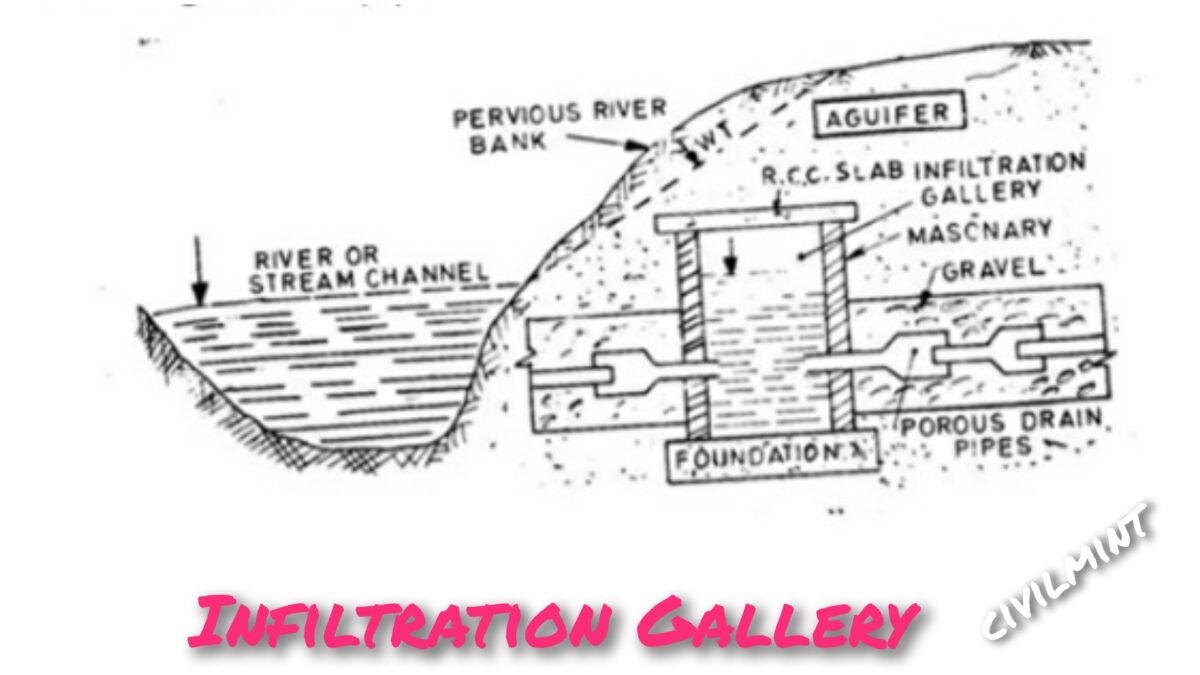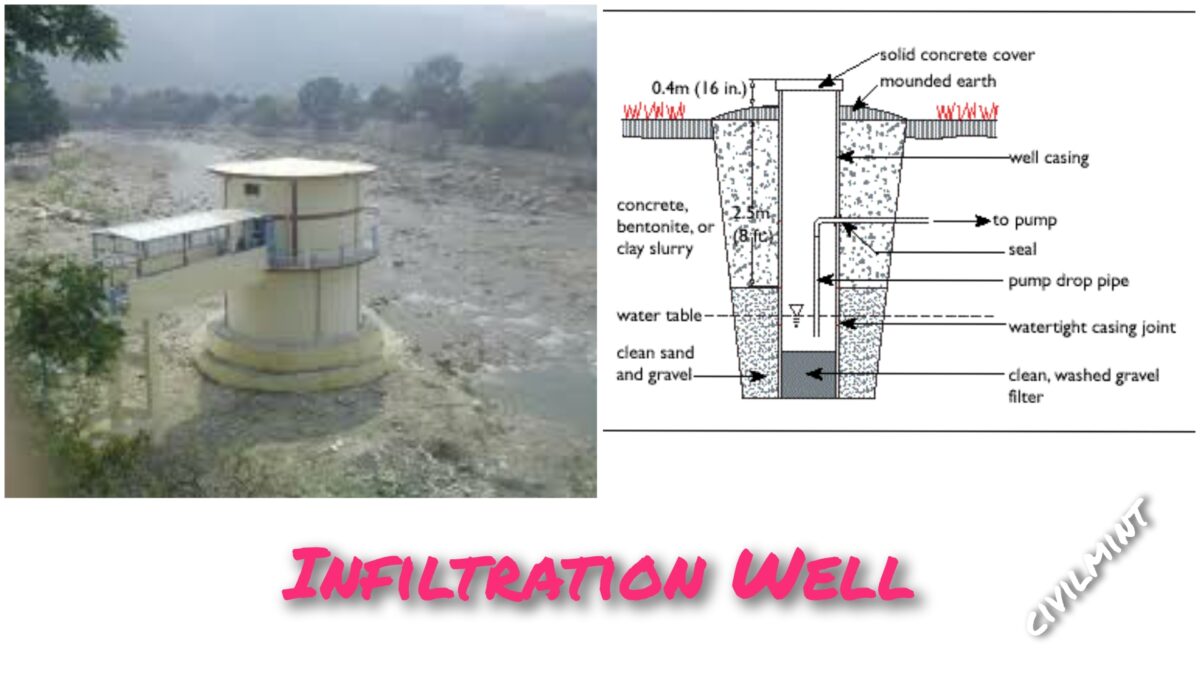An infiltration gallery is a type of drain structure designed to collect groundwater from subsurface water levels. It typically uses open jointed or perforated pipes, or block drains, and is situated below the water table. Infiltration galleries can also be utilized to collect water from the subsurface of rivers.

Table of Contents
What Is Infiltration Gallery?
An infiltration gallery is a subsurface water supply system that collects groundwater from a horizontal drain situated below the water table. It is designed to resemble a drain and is responsible for sourcing water from subsurface sources. The structure of the gallery is usually comprised of open jointed or perforated pipe that allows for the collection of water.
Once the water has been collected, it is taken to a sump or collecting well where it can be pumped out for use. This system is commonly used to provide a reliable and sustainable source of water for various purposes.
Working Concept
Other water supply systems are often combined with the construction of an infiltration gallery to meet the increasing demand for water. This is because the infiltration gallery alone may not be sufficient to meet the entire supply-demand.
A permeable soil surrounding the infiltration gallery is required for optimal functioning, which allows water to easily infiltrate. Permeable soil material like gravel, which has large components, facilitates water infiltration while preventing large unwanted particles from clogging the perforated holes.
Construction of multiple infiltration galleries is generally done and connected to a central point, such as a hand-dug well, which is referred to as the collecting well.
To ensure that the galleries remain uncontaminated, they maintain a safe distance of at least 30 meters on all sides from potentially contaminated areas. This distance may vary based on the specific site and situation.
The location of the infiltration gallery is at a safe distance from unfiltered surface water sources.
Water that is collected through infiltration galleries is directed to the collecting well and subsequently transported to meet the supply-demand through a pumping system or other water supply system.
Difference Between Infiltration Gallery And Infiltration Well
I have thoroughly described the difference between infiltration gallery and infiltration well. Read the table below:
| Feature | Infiltration Gallery | Infiltration Well |
|---|---|---|
| Design | Infiltration galleries are designed as long, horizontal trenches. | Infiltration wells are designed as vertical shafts that are dug into the ground. |
| Shape | Infiltration galleries typically have a rectangular or square shape. | Infiltration wells are usually circular or square in shape. |
| Depth | Infiltration galleries are typically shallow, with depths of less than 10 feet. | Infiltration wells are generally deeper, with depths typically exceeding 10 feet. |
| Diameter/width | Infiltration galleries are wide, usually between 4-10 feet in diameter or width. | Infiltration wells are narrower, usually between 2-4 feet in diameter or width. |
| Length | Infiltration galleries can be several hundred feet long. | Infiltration wells are typically shorter than galleries. |
| Intake structure | Infiltration galleries have intake structures located at one or both ends of the gallery. | Infiltration wells have intake structures located at the top of the well. |
| Intake mechanism | Water flows through the porous walls or bottom of an infiltration gallery. | Water flows through gravel or perforated casing in an infiltration well. |
| Capacity | Infiltration galleries have a larger capacity than infiltration wells. | Infiltration wells have a smaller capacity than infiltration galleries. |
| Maintenance | Infiltration galleries require regular cleaning and removal of sediment. | Infiltration wells require periodic removal of sediment and debris. |
| Appropriate terrain | Infiltration galleries are appropriate for flat terrain with shallow groundwater. | Infiltration wells are appropriate for steep terrain with deep groundwater. |
| Applicable Uses | Infiltration galleries are appropriate for small to medium-sized flows, urban or suburban areas, and where space is available. | Infiltration wells are appropriate for larger flows, rural areas, and where space is limited. |
What Is Infiltration Well?
An infiltration well manages the quantity and quality of runoff from impervious surfaces such as roads, parking lots, and rooftops.

An infiltration well consists of a deep vertical borehole that people fill with permeable materials such as gravel or sand, which allows stormwater to slowly infiltrate into the surrounding soil.
The purpose of an infiltration well is to recharge groundwater and reduce the volume and velocity of stormwater runoff.
When an infiltration well allows stormwater to infiltrate into the soil, it can help replenish groundwater supplies and reduce the risk of flooding and erosion downstream.
People use infiltration wells in areas where traditional stormwater management practices, such as detention ponds or retention basins, are not feasible due to space limitations or other constraints.
People can also use infiltration wells in conjunction with other stormwater management practices as part of an overall strategy to reduce the impacts of urbanization on the natural water cycle.
Design, Construction And Maintenance
Carefully select the site of the infiltration gallery based on a variety of factors, including geology, hydrology, and land use. Ensure that the location is accessible and away from potential sources of contamination.
Size the infiltration gallery based on the amount of water that needs to be stored or infiltrated, as well as the porosity of the surrounding soil.
Design the infiltration gallery to maximize the amount of water that can be stored or infiltrated. This typically involves using a perforated pipe or a series of pipes surrounded by a layer of gravel or other permeable material.
Use durable and corrosion-resistant materials, such as concrete, steel, and PVC, for the construction of the infiltration gallery.
Perform regular cleaning of the collection system and monitor water quality to ensure the continued effectiveness of the infiltration gallery.
Take safety considerations into account during the design and construction of the infiltration gallery. Ensure that the structure is properly secured and that there is adequate ventilation.
Ensure that the design of the infiltration gallery complies with local and national regulations regarding groundwater management and environmental protection.
Uses Of Infiltration Gallery
- Infiltration gallery is used when direct surface water is contaminated or unsuitable for use.
- The water supply system mainly uses infiltration gallery to take out subsurface water when surface water is not available and there is a need to fulfill the requirement.
- Infiltration gallery collects water from aquifers below the water table, which is an easily available water resource, and collects it in the well for irrigation and other uses.
- It is specially used in dried areas where surface water resources are not available to the water supply system, and where surface runoff is more.
